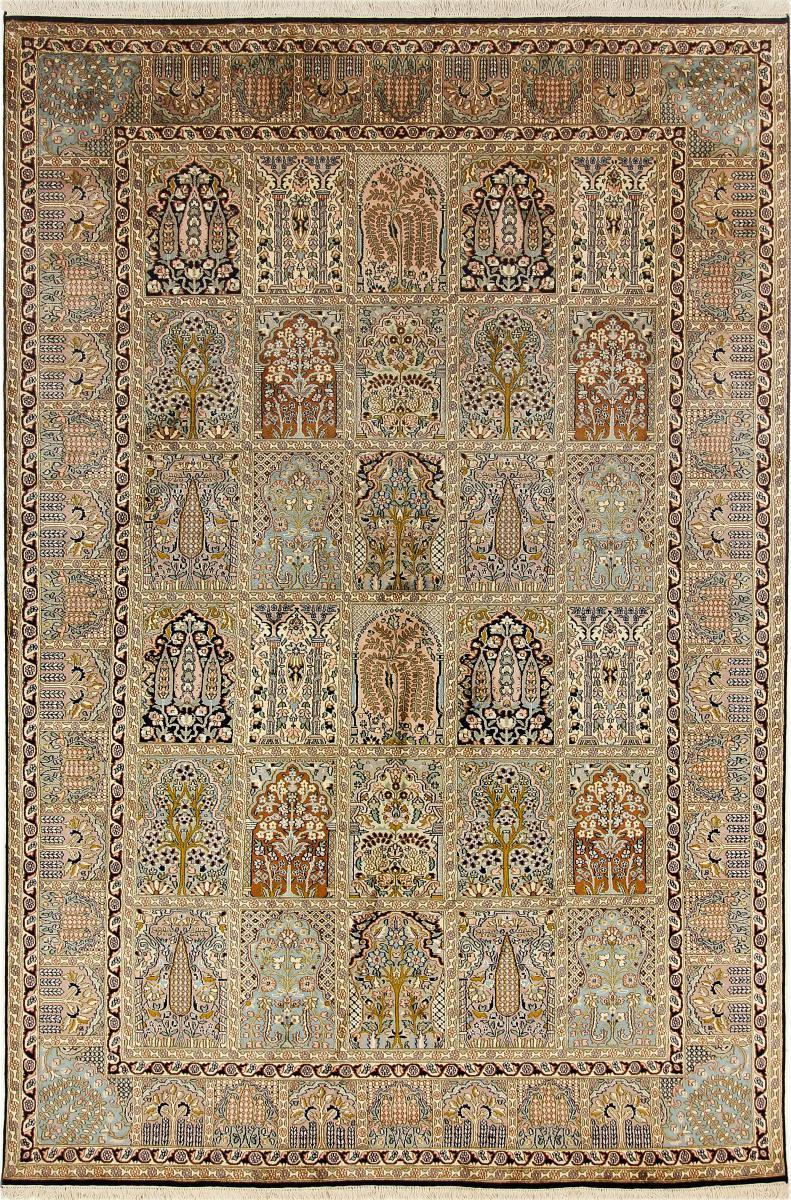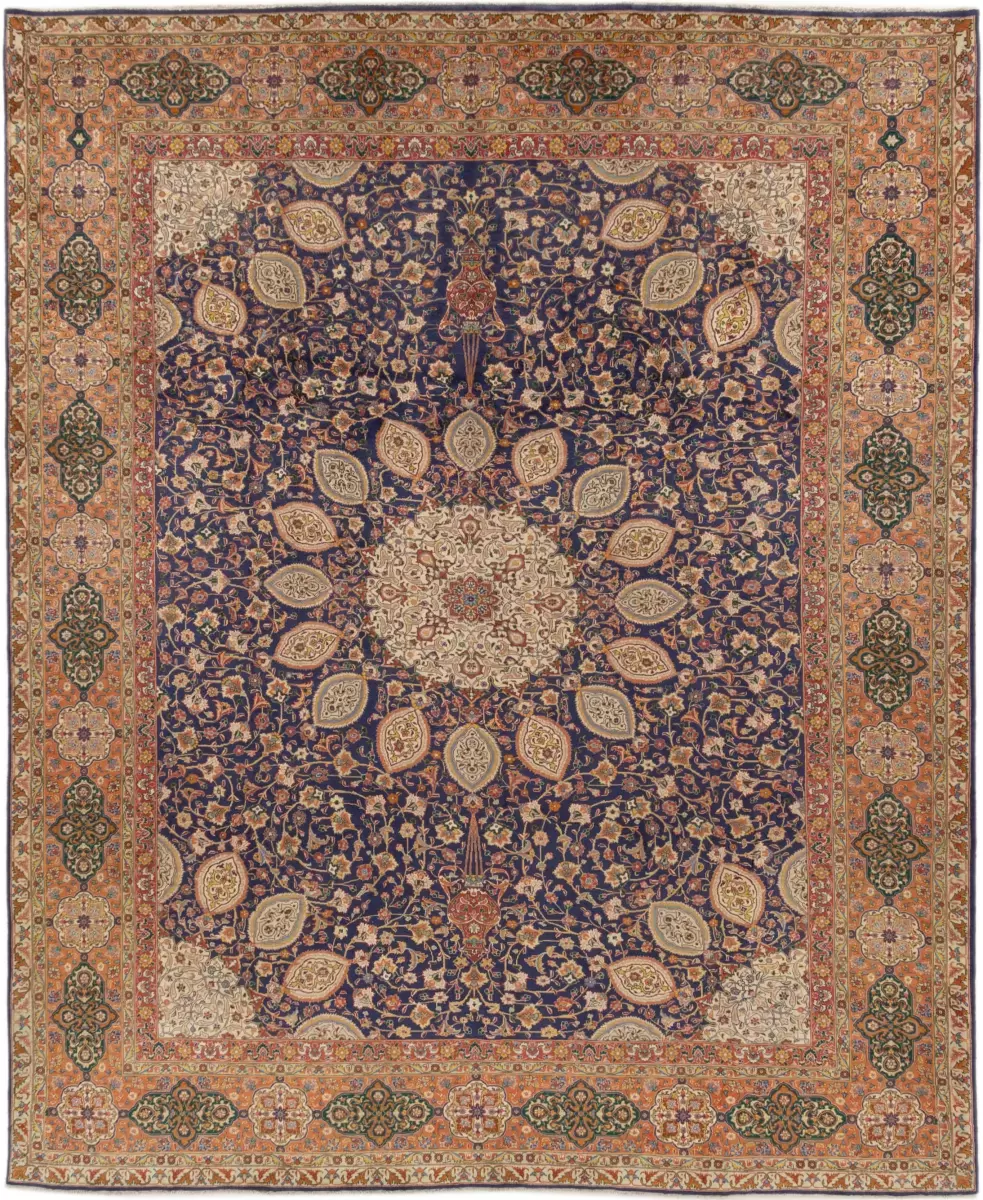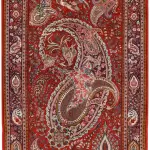Soof handmade carpet
Soof carpets are a special type of hand-woven carpets that are woven using silk and sometimes gold or silver. These carpets have a special and luxurious effect due to their outstanding weaving and the use of precious materials. They are one of the prominent examples of weaving art in Iran, which depict the rich history and culture of the Soof region. These carpets, with their unique designs and complex textures, not only represent the high skills of local weavers, but are also part of the cultural and artistic identity of this region. This traditional art, with its ancient history and special techniques, is still known as one of the valuable cultural treasures of Iran. In this article, we will examine the characteristics, history and status of Soof handwoven carpets and explore their role in preserving and developing the art of traditional weaving.
History and background of Soof carpet
Soof carpets were introduced for the first time in Kashan and their history dates back to more than a century and a half ago. At first, these beautiful carpets were woven exclusively for the Safavid court and only a limited number of them were sold in the market. With the passage of time, European traders became interested in buying Souf carpets and since then the export of these carpets began.
After the Souf carpet arrived in Europe, a few sheets of it were gifted to the Duke of Venice. In Iran, the texture of this carpet gradually spread in the city of Tabriz. Tabriz carpets are known as one of the most reliable handwoven carpet brands and today the best examples of this carpet are produced in Tabriz.
The peak of popularity of Souf carpet in Europe dates back to the late 16th and early 17th centuries. During this period, about 800 boards of this carpet were woven in Europe. Due to its special and unique texture, Souf carpets have gained great popularity among people all over the world.
Soofa carpet in the modern world
In the modern world, the design and use of couch carpets have undergone changes to be more compatible with today's tastes and needs. One of the most important changes is matching traditional designs and colors with modern decorations. Today, minimalist designs and more neutral colors are used alongside traditional designs to match modern interior styles. These changes have caused Souf carpets to find a prominent place as a decorative and functional element in various decorations from modern homes to commercial and cultural spaces.
Also, the use of silk and more luxurious fibers in some modern versions of Soofa rugs has made these products a suitable option for people who are looking for special rugs with high artistic value. These changes have increased the appeal and use of Soofa carpets in the modern world.
Special features of Soof handwoven carpet
Raw materials and colors used
Soof handwoven carpets are known for using quality raw materials and their beautiful and natural colors. The main fibers used in the weaving of these carpets include wool, silk, and in some cases, mixed yarns. Wool, which is obtained from the down and natural wool of camels, goats and sheep, is used as one of the main materials in the weaving of Soofa rugs due to its durability and Sooftness. Silk is also used in a limited way to add shine and luster to carpets.
Different types of yarn are used for the weaving of Souf carpet, which are mainly divided into three categories: pile yarn, simtab yarn, and warp and weft yarn. Pile yarns, which are used to weave the prominent parts of the carpet, give the carpet a special charm with various and beautiful colors. Simtab threads, divided into three categories, gold, silver and copper, are used to create beautiful details and patterns on the carpet, giving it a magnificent effect. Based on the type of simtab thread used, Souf carpets are known as talabaf or agbarbaf. The warp and weft yarns, which are used for the main structure of the carpet, are usually made of silk and give the carpet a Sooft texture. However, sometimes to reduce cost or for other reasons, cotton yarns are also used for warp and weft weaving. The combination of these threads gives the Soof carpet a special beauty, texture and durability and turns it into one of the symbols of Iran's handwoven art and craft.
In the field of colors, Souf carpets usually use natural and plant colors that are obtained from raw materials such as plant roots, fruits, and minerals. These colors usually include Sooft and warm colors such as reds, creams, blues, greens and browns that blend well with each other to create a beautiful and well-proportioned effect. The use of natural colors not only helps the durability of the colors, but also gives more beauty and harmony to the carpet designs.
Texture techniques
Soof handwoven carpets are produced using special weaving techniques that have been traditionally passed down from past generations. One of the important techniques in the weaving of these carpets is the "knotted texture" by which the weavers can create complex and coherent designs. This texture is known for its high strength and durability, especially in Souf carpets.
The use of special weaving and design techniques gives Soof hand-woven carpets unique characteristics that distinguish them from other Iranian carpets. These features, along with quality raw materials and natural colors, have made Souf carpets not only recognized as durable and beautiful products, but also as valuable works of art in the world market.
Talafaf or silver woven carpet
The names "Talabaf" and "Naqrebaf" mean "fabrics woven from gold or silver" and were especially noted in the production of Suf carpets since the Safavid era. After the Baharestan carpet, the Safavid kings tried to create a new and eye-catching work that reminds of the beauty of the Baharestan carpet. In this way, they succeeded in producing talabaf and silver-woven carpets, which were known as export goods during the Safavid period and were very popular.
These carpets, which were woven with gold and silver in addition to silk, had a brilliant and unique effect. The beauty and splendor of these carpets were so great that anyone hearing their name would form an image of stunning and legendary beauty in their mind. Long-term observation of these carpets never tired the eyes, and for this reason, talabaf and silver-woven carpets were known as a symbol of art and beauty in all eras.
Soof handmade carpet production process
The production process of handmade Souf carpet includes several detailed and specialized steps, each of which plays an important role in creating a quality carpet. This process begins with the selection of quality fibers, such as natural wool and silk. After the fibers are collected, they are washed and dried and carefully turned into threads for weaving. In the next step, design and mapping is done. These designs usually include geometric or floral patterns that the weaver follows precisely using detailed blueprints. Then the weavers weave the threads regularly on the carpet loom with techniques such as knot weaving, using carpet looms and special tools such as rakes and combs. After finishing the weaving, the carpet is washed and decorated to achieve the desired Sooftness and shine. Finally, the rug is cut and edged to be ready for display and sale. Special tools and techniques used in this process, such as the use of natural colors and knotted texture, give Soof carpets unique characteristics that distinguish them from other Iranian carpets.

Common designs and patterns in Soof handwoven carpets
The common designs and patterns in Soof handwoven carpets are a combination of traditional patterns and natural and cultural inspirations of the region, which are artistically and with detailed details on the carpets. Some of the most common designs and motifs are:
Geometric designs:
Rugs: These designs include simple, symmetrical geometric patterns that are usually repeated in the form of rhombuses, squares, or triangles throughout the rug. These patterns depict traditional symbols and sometimes abstract forms of nature.
Bete Jaqe: one of the famous patterns that is in the shape of a bete or a bent leaf and has its roots in Iranian culture. This design is often used repeatedly in couch rugs.
Floral designs:
Flower and bush: These designs include flower and plant motifs that are repeated symmetrically or scattered throughout the carpet. Various flowers are depicted with fine details and natural colors.
Shah Abbasi flower: one of the famous motifs in Iranian carpets, which can also be seen in Soof carpets. The motif is usually a large flower in the center of the rug, surrounded by smaller flowers and intricate foliage.
Designs inspired by nature:
Tree of life: a famous design that can be seen in many traditional Iranian carpets. This design is a symbol of life and growth and is usually placed in the middle of the rug.
Animals: Some Souf rugs have motifs of local animals such as birds, deer and lions, woven symbolically and with fine detail.
Combined designs:
Taranj and Lakh: This design includes a central pattern (Tranj) and four lachs in the four corners of the carpet, which are woven harmoniously and symmetrically. This pattern is especially common in large rugs.
Advantages and disadvantages of couch carpets
Advantages:
High quality and durability: Souf handwoven carpets have high durability and strength due to the use of high-quality raw materials such as natural silk and precise weaving techniques. These carpets can be used for years without reducing their quality and beauty.
Unique Designs: Soof rugs are known for their unique designs and motifs, often inspired by the nature, culture and art of the region. These designs turn couch rugs into works of art that can beautify any space.
Artistic and cultural value: As a representative of authentic Iranian art and culture, these carpets have a high artistic and cultural value and are especially valued as valuable works of art in international markets.
Natural colors: The use of natural and vegetable colors in Soof carpets gives them a special shine and beauty that does not change or fade over time.
Disadvantages:
High price: Due to the use of quality raw materials and the time-consuming weaving process, Soof hand-woven carpets usually have a high price. This may make them inaccessible to some buyers.
Need for special care: These carpets need special care and maintenance due to their high value. To maintain the quality and durability of the carpet, they should be cleaned regularly and kept away from direct sunlight and moisture.
Heavy weight: Due to the high density of knots and the use of heavier fibers, couch rugs may weigh more than some other rugs, which can make them more difficult to move and transport.
Vulnerability to moisture: Like many hand-woven carpets, couch carpets are also sensitive to moisture and may be damaged or deformed if placed in humid environments.
The quality and durability of Soof handwoven carpets
Soof handwoven carpets are durable and long-lasting due to the use of quality raw materials and unique weaving techniques. These rugs are mainly woven using high quality natural wool and in some cases silk, both of which contribute to the durability and strength of the rug. The knotted weaving process used in the production of these carpets leads to an increase in the carpet's resistance to wear and long-term use. Also, the use of natural and herbal colors helps to maintain the colors over time and prevents them from changing or fading.
The quality of Soof carpets is also very high due to the high density of knots. The density of knots per square centimeter of the carpet not only contributes to the detail and clarity of the designs, but also makes the carpet more resistant to pressure and daily use. These features make Soofa carpets, even after years of use, still maintain their original appearance and remain unchanged.
How to maintain and care for Soofa carpets
Proper care and maintenance is very important to maintain the quality and durability of handmade Souf carpets. Some key points for maintaining these carpets are:
Dust and everyday dirt can damage carpet fibers over time. It is recommended to sweep Soofa carpets regularly to remove dust from the surface of the carpet. Using a vacuum cleaner with the right power can help keep the carpet clean.
Although it is not necessary to wash carpets regularly, periodic professional cleaning (once every few years) can help maintain the shine and Sooftness of the carpet. It is necessary to use mild detergents and water at the right temperature to prevent damage to fibers and colors.
Direct sunlight can cause the carpet's natural colors to fade. It is better to place Soofa carpets in a place where they are not exposed to direct sunlight or use curtains and solar protectors.
Rotating the rug every few months can help even out the wear and tear and prevent worn spots in one particular area.
Using a special carpet underlay can prevent slipping and wrinkles in the carpet and help increase the life of the carpet.
The main producing areas of Soof carpets
Soof handwoven carpets are mainly produced in areas of Iran that have become the main centers of this industry due to a long history in the art of weaving. One of the most important producing areas is Nain city in Isfahan province, which is famous for its high elegance carpets and special designs. Birjand city in South Khorasan province is also one of the production centers of Souf carpets, whose patterns are often inspired by nature and local culture. Also, Kashan city in Isfahan province, as one of the historical centers of carpet production, is also active in the production of Soof carpets. Kashan produces carpets with high artistic value with various designs and high-quality fibers. Ardakan city in Yazd province is also one of the important areas for the production of Soof carpets, which is especially known for its geometric designs and special colors.
Final word
As a result, Soof hand-woven carpets not only represent original art and rich culture, but also have a special place in the world of carpet weaving art and industry as lasting and valuable works. By combining traditional skills and modern creativity, these carpets have been able to adapt to contemporary needs and tastes and continue to maintain their position in the domestic and international markets. Soof carpet producing areas, using special weaving techniques and using quality raw materials, produce works that are not only artistically remarkable, but also at a high level in terms of quality and durability. Finally, as a cultural and artistic heritage, Soof carpets represent a deep connection between the past and the present and help to preserve and transfer this valuable art to future generations.
You can inquire about Buying Handwoven Carpets , Buying Handwoven Kilim and Mats ,and Buying Handwoven Pictorial Rug Tableaus online from the Hoveida Carpet Store and register all your orders and Wherever you are in the world, deliver it to the desired address in less than 4 working days.
If you are interested in reading other articles in the field of Handwoven carpets or Handwoven Pictorial Rug Tableaus , please refer to Hoveida Carpet Commercial .
Leave a comment
Your email address will not be published. Required fields are marked *












